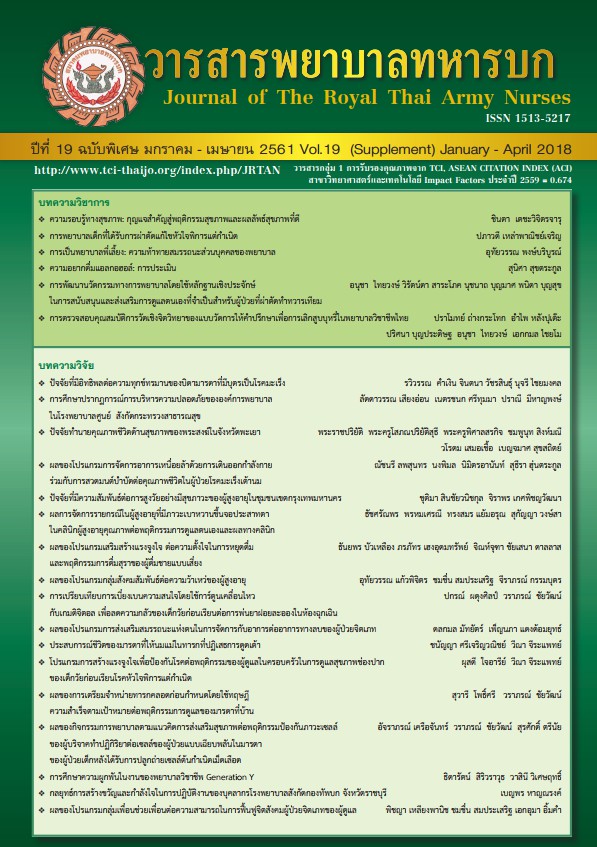Comparison of Distraction by Animation and Digital Game on Preschool Children’s Fear of Aerosol Therapy in Emergency Room
Keywords:
Fear, Distraction, Aerosol therapy, Preschool childrenAbstract
The purpose of this quasi-experimental research was to compare the distraction by animation and by digital games on children’s fear of children receiving aerosol therapy in an emergency room. Sixty preschool children with acute respiratory infection or asthma treated by aerosol therapy in the emergency room of the Queen Sirikit National Institute of Child Health were randomly assigned to the control group, the distraction by animation group, and the distraction by digital games group. Children’s fear was collected by the Aerosol Therapy Fear Behavior Scale of Chirawachr Kasemsook and Waraporn Chaiyawat (2555). Its Content Validity Index was .95 and its interrater reliability coefficient was .95. Data were analyzed by ANOVA. Findings were as follows. (1) Preschool children receiving distraction by animation had significant less fear of aerosol therapy than those receiving routine nursing care, at the statistical level of .05. (2) Preschool children receiving distraction by digital games had significant less fear of aerosol therapy than those receiving routine nursing care, at the statistical level of .05. (3) Fear of aerosol therapy of preschool children receiving distraction by animation and by digital games were not different.
Downloads
References
2. Hockenberry MJ, Wilson D. Wong’s Essentails of Pediatric Nursing. 8th ed. St.Louis: Mosby; 2009.
3. Chaisupmongkollarp T, Humidity and Aerosol therapy. In: Tungsubud Y, Pinyoo A, Chaisupmongkollarp T, Triwong D, editors. Principle and Technique in Nursing. Nonthaburi: Yuttarin print; 2553: 154-68. (in Thai).
4. Treewichar W, Khungtumneam K, Buajalearn H. Guideline for Management the Acute Exacerbation at home by Chronic Obstructive Pulmonary Disease: COPD patient. Journal of Royal Thai Army Nurses, 2017; 18(1): 216-221. (in Thai).
5. Kasemsook C, Chaiyawat W. The effect of the concrete-objective information program on fear aerosol therapy of preschoolers with acute respiratory infections. Journal of nursing science Chulalongkorn university, 2555; 23: 96-104. (in Thai).
6. Lazarus RS, Folkman S. Stress, Appraisal, and Coping. New York: Springer Publisher; 1984. Chaiyawat W, Jezewski MA. Thai school-age children’s perception of fear. Journal ofTranscultural Nursing. 2006; 17: 74-81.
7. Bassham S, Brian KI, MacKeil-White K, Fischer J, Arnold, D., Whatley V, Walsh M. Difficult airways, difficult physiology and difficult technology: Respiratory treatment of the special needs child. Respiratory Treatment of the Special Needs Child. 2009; 13: 81-90.
8. Teeratakulpisarn J. Asthma in children: update Srinagarind Medical Journal. 2554; 26: 54-62. (in Thai).
9. Kleiber C. Distraction. In: Craft RM, Janice D, editors. Nursing Interventions for Infants, Children, and Families. United State of America; 1990.
10. Taylor C, Lillis C, Lemone P. Fundamentals of nursing: The art and science of nursing care. 5th ed. Philadelphia; 2005.
11. Nilsson S, Enskar K, Hallqvist C, Kokinsky E. Active and passive distraction in children undergoing wound dressing. Journal of Pediatric Nursing. 2013; 28: 158-66.
12. Sil S, Dahlquist LM, Andrew J, Burns P. Case Study: Videogame Distraction Reduces Behavioral Distress in a Preschool-Aged Child Undergoing Repeated Burn Dressing Changes: A Single-Subject Design. Journal of Pediatric Psychology. 2013; 38: 330-41.
13. Koller D, Goldman RD. Distraction techniques for children undergoing procedures: A critical review of pediatric research. Journal of pediatric nursing. 2012; 27: 652-81.
14. Polit, D.F., Hungler, B.P. Nursing Reseach Principle and Methods. 5th ed. Philadelphia; 1999.
15. Yoo H, Kim S, Hur H-K, Kim HS. The effects of an animation distraction intervention on pain response of preschool children during venipuncture. Applied Nursing Research. 2011; 24: 94-100.
16. Jameson E, Trevena J, Swain N. Electronic gaming as pain distraction. Pain Research and Management. 2011; 16: 27-32.
17. Anukoolrangsan S. Effects of minigames with self-regulation toward english critical reading a chievement of twelfth grade students [Master of Education Program in Educational Administration]. Bankok: Chulalongkorn university., 2011. (in Thai).
18. Hamel SC, Pelphrey A. Preschool Year. In: Carey WB, editors. Developmental-Behavioral Pediatric. 4rd ed. Philadelphia: Saunders Elsevier; 2009.
19. Chonchaiya V. Application of touch point for the care of children in general pediatric practice. In: Hunsakunachai T, Rungphaiwan R, Sujaritpong S, Chonchaiya V, editors. Development and Behavioral pediatrics : volume3 Children Healthy. Bangkok: Beyoung enterprice; 2556. 30-7. (in Thai).
20. Kulvichit J, Playing in Patients. 2rd ed. Songkhla: Chanmaung print; 2552. (in Thai). 21. Mc Caffery M, Pasero C. Pain Clinical Manual. 2rd
ed. St. Louis: Mosby; 1999.
Downloads
Published
How to Cite
Issue
Section
License
บทความหรือข้อคิดเห็นใดใดที่ปรากฏในวารสารพยาบาลทหารบกเป็นวรรณกรรมของผู้เขียน ซึ่งบรรณาธิการหรือสมาคมพยาบาลทหารบก ไม่จำเป็นต้องเห็นด้วย
บทความที่ได้รับการตีพิมพ์เป็นลิขสิทธิ์ของวารสารพยาบาลทหารบก
The ideas and opinions expressed in the Journal of The Royal Thai Army Nurses are those of the authors and not necessarily those
of the editor or Royal Thai Army Nurses Association.






